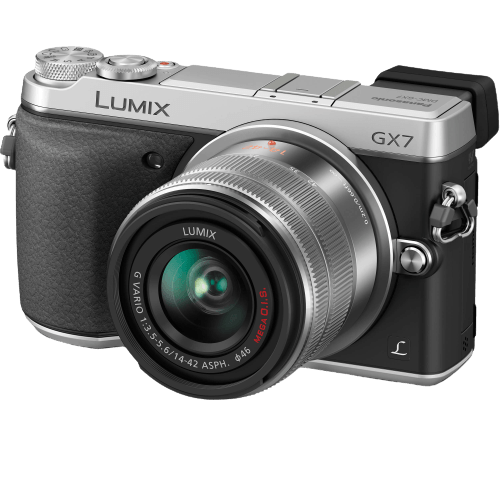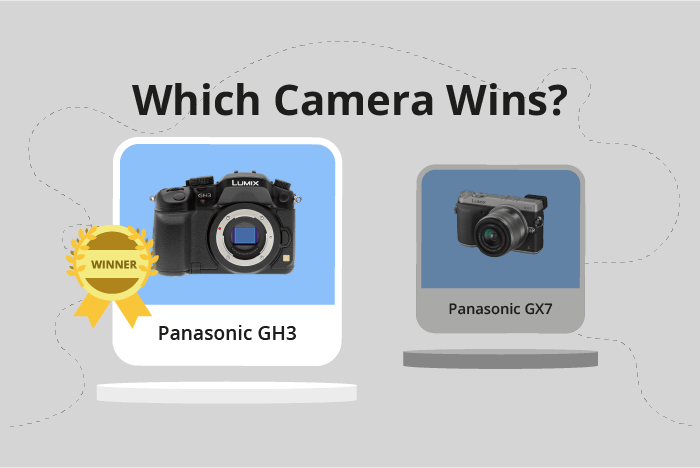Panasonic Lumix DMC-GH3 vs Lumix DMC-GX7 Comparison
Panasonic Lumix DMC-GH3

Panasonic Lumix DMC-GX7

The Panasonic Lumix DMC-GH3 outperforms the Panasonic Lumix DMC-GX7 by a slight margin, with a score of 53/100 as opposed to 52/100. Both cameras are mirrorless and were released in 2012 and 2013, respectively. They share some common specifications, such as camera type and similar announcement dates.
The GH3 has some advantages over the GX7, including a larger size (133 x 93 x 82mm) and a heavier weight (550g / 1.21lbs), which may provide better stability and handling for some users. Additionally, it had a higher launch price of $1300, indicating more premium features.
On the other hand, the GX7 is more compact (123 x 71 x 55mm) and lightweight (402g / 0.89lbs), making it easier to carry around. It also had a lower launch price of $999, making it more affordable for budget-conscious consumers.
Taking these factors into account, the GH3 is a slightly better camera overall, while the GX7 offers a more portable and budget-friendly option.
Panasonic Lumix DMC-GH3 vs Lumix DMC-GX7 Overview and Optics
The Panasonic Lumix DMC-GX7 outperforms the Panasonic Lumix DMC-GH3 in terms of optics, with a score of 54/100 compared to the GH3’s 50/100. Both cameras share several similarities in their specifications, such as having 16-megapixel CMOS sensors, Micro Four Thirds sensor size, and Micro 4/3 lens mounts. They also share similar processors, with the GH3 having a Venus Engine VII FHD and the GX7 having a Venus Engine.
The Lumix DMC-GX7 surpasses the GH3 in one crucial area: image stabilization. This feature helps reduce the impact of camera shake, resulting in sharper images. This advantage alone makes the GX7 a better choice for those who prioritize image quality and stability.
On the other hand, the Lumix DMC-GH3 has a higher shooting speed of 20 frames per second, compared to the GX7’s 5 frames per second. This makes the GH3 more suitable for capturing fast-moving subjects or action shots. Additionally, the GH3 has a slightly higher DXOMARK score for its sensor at 71, compared to the GX7’s score of 70. This difference, however, is minimal and may not significantly impact the overall image quality.
Taking these factors into account, the Panasonic Lumix DMC-GX7 proves to be the better option for those who value image stabilization and overall image quality. The Lumix DMC-GH3, while slightly inferior in optics, may be more suitable for users who require a faster shooting speed for action photography.
Panasonic Lumix DMC-GH3 vs Lumix DMC-GX7 Video Performance
The Panasonic Lumix DMC-GH3 outperforms the Panasonic Lumix DMC-GX7 in video capabilities, scoring 70/100 compared to the GX7’s 56/100. Both cameras share some common specifications, including Full HD video resolution, maximum video dimensions of 1920 x 1080, and a maximum video frame rate of 60fps. However, there are key differences that contribute to the GH3’s higher score and superior performance.
The GH3 surpasses the GX7 with its built-in time-lapse functionality. This feature allows users to create stunning time-lapse videos without the need for additional equipment or software, making it a more versatile option for videographers. The GX7 lacks this feature, which limits its creative potential for video projects.
On the other hand, the GX7 excels in its compact design and portability. While this does not directly impact its video capabilities, it may be a deciding factor for users who prioritize a lightweight and easy-to-carry camera. However, this advantage does not outweigh the GH3’s superior video features.
In comparing the video capabilities of the Panasonic Lumix DMC-GH3 and DMC-GX7, it is clear that the GH3 is the better choice for those seeking advanced video features, such as built-in time-lapse functionality. Although the GX7 offers a more compact design, it falls short in providing the same level of video performance as the GH3.
Panasonic Lumix DMC-GH3 vs Lumix DMC-GX7 Features and Benefits
The Panasonic Lumix DMC-GH3 emerges as the winner in this comparison with a feature score of 65/100, while the Panasonic Lumix DMC-GX7 trails behind with a score of 57/100. Both cameras share several common specifications, such as a 3-inch screen size, touchscreen capability, flip screen, absence of GPS, presence of WIFI, and lack of Bluetooth.
The Lumix DMC-GH3 outperforms the Lumix DMC-GX7 in screen resolution, boasting 614,000 dots compared to the GX7’s 1,040,000 dots. This higher resolution provides the GH3 with a clearer and more detailed display, enhancing the user’s experience while framing shots and reviewing images.
On the other hand, the Lumix DMC-GX7 has some advantages over the GH3, despite its lower feature score. The GX7’s screen resolution is significantly higher, offering a more detailed and sharper display. This advantage can be beneficial for photographers who prioritize image quality when reviewing their shots on the camera’s screen.
In conclusion, the Panasonic Lumix DMC-GH3’s higher feature score of 65/100 reflects its superiority over the Lumix DMC-GX7 with 57/100. The GH3 excels with a higher screen resolution, while the GX7 still offers some benefits in terms of a more detailed and sharper display. Ultimately, the choice between the two cameras will depend on individual preferences and priorities, with the GH3 being a better option for those seeking a higher overall feature score and the GX7 catering to photographers who value a more detailed screen display.
Panasonic Lumix DMC-GH3 vs Lumix DMC-GX7 Storage and Battery
The Panasonic Lumix DMC-GH3 wins in the storage and battery category with a score of 27/100, compared to the Panasonic Lumix DMC-GX7’s score of 21/100. Both cameras share some similarities in this aspect, such as having a single memory card slot and accepting SD, SDHC, and SDXC memory cards. Neither camera offers USB charging.
The DMC-GH3 outperforms the DMC-GX7 in battery life, offering 540 shots per charge compared to the latter’s 350 shots. This is due to the DMC-GH3’s higher capacity Li-ion, 1600 mAh battery, while the DMC-GX7 uses a Li-Ion, 7.2V, 1200 mAh battery. The longer battery life of the DMC-GH3 is advantageous for extended shooting sessions and minimizes the need to carry spare batteries.
On the other hand, the DMC-GX7 does not have any specific advantages in storage and battery capabilities over the DMC-GH3. Both cameras share similar storage options and lack USB charging.
Considering the longer battery life of the DMC-GH3, it is the better choice in terms of storage and battery performance. The DMC-GX7 falls short in this category, offering no advantages over its counterpart.
Panasonic Lumix DMC-GH3 vs Lumix DMC-GX7 – Our Verdict
Are you still undecided about which camera is right for you? Have a look at these popular comparisons that feature the Panasonic Lumix DMC-GH3 or the Panasonic Lumix DMC-GX7:

